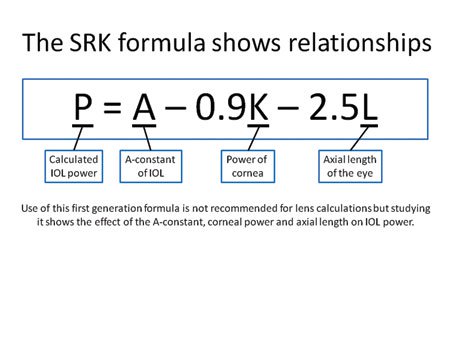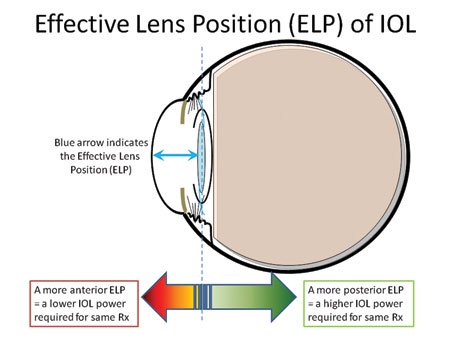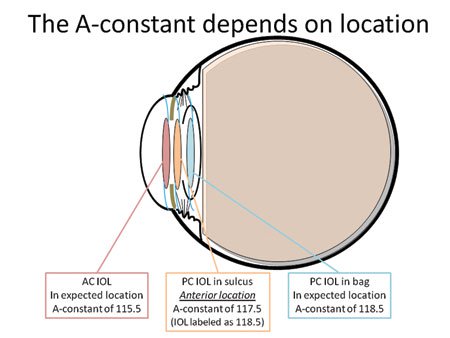Refining the A-constant yields more accurate refractive results after cataract surgery
Refractive outcome is influenced by lens position, lens geometry and refractive index of lens material.
By customizing the power of the lens implanted during cataract surgery, we can provide a specific refractive result to our patients. This means that even patients who are highly myopic or hyperopic can achieve a near plano result after IOL implantation. But our calculations for the ideal IOL power are not perfectly accurate; rather, they are estimations based on preoperative biometry.
Differences in IOL designs
Not all IOLs that are labeled as +20 D will provide the same postoperative refractive result, even if used in identical eyes. The reason is that while the lens power may actually be +20 D when measured outside the eye, the lens position in the eye, the lens geometry and the refractive index of the material can all influence the refractive outcome. These factors are represented in the A-constant that is individualized for each IOL.
If we look at the original SRK formula (which is no longer used), we can see that a change in the A-constant results in a change to the IOL power with a 1:1 ratio. The corneal power also affects the IOL power calculation at a ratio of 0.9:1, but a small change in the axial length can greatly change the IOL power calculation due to its ratio of 2.5:1.

Uday Devgan
Effect of A-constant on IOL power
The term “A-constant” seems misleading because unlike mathematical constants such as pi or e, it varies among IOL models and even among surgeons. When manufacturers make an IOL, they determine a good initial value for the A-constant considering the wide pool of surgeons who will be using the lens. This value is then honed by each surgeon to reflect his surgical technique and the variance of his preoperative biometry. If a surgeon has a keratometer that consistently measures the cornea as slightly steeper than it truly is, he can adjust his A-constant higher to compensate for that. If the axial length determination gives a value that is shorter than the true value, the A-constant can be lowered proportionally.
When switching from one model of IOL to another, the A-constant can also change. If we have done lens calculations for IOL brand No. 1, which has an A-constant of 118.4, and have determined that a lens power of +21.0 D will give a postop result of plano, and then we decide to change to IOL brand No. 2, which has an A-constant of 118.9, we must change the IOL power to +21.5 D to get the same plano postop refraction. The A-constant varies 1:1 with the IOL power, so if we change the IOL A-constant by +0.5 (going from 118.4 to 118.9), then we must also change the IOL power by +0.5 (going from +21.0 D to +21.5 D) to get the same desired postop result.
In cases in which we plan to implant an anterior chamber IOL, the correct adjustment of the calculated posterior chamber IOL power is also related to the A-constant. Using the example above in which we calculated that a +21.0 D IOL with an A-constant of 118.4 implanted in the capsular bag would give a plano result, using an anterior chamber IOL with an A-constant of 115.4 would mean that a +18.0 D anterior chamber IOL should give the same plano refraction after surgery.
In cases in which we implant an IOL in an alternate location from what is intended, the A-constant needs to be adjusted. For example, a three-piece IOL has an A-constant of 118.4 for placement in the capsular bag. However, if we implant this same IOL in the ciliary sulcus, which is a more anterior location, then we must adjust the A-constant down to lower the IOL power. The more anterior that we place a lens, the lower the A-constant and resultant IOL power will be, and the more posterior, the higher. This is why surgeons often use the rule of thumb to subtract 1 D from the lens power when placing a lens in the ciliary sulcus of an average eye.

Figure 1. The first-generation SRK formula is not recommended for lens calculations but studying it shows the relationships between factors that affect calculated IOL power. Note that the A-constant affects the IOL power in a 1:1 ratio.
Source: Devgan U

Figure 2. The effective lens position of the IOL determines the final postoperative refraction. If the IOL is more anteriorly placed, then a lower IOL power will be required, while a more posterior position will require a higher IOL power for the same postop refraction.

Figure 3. The A-constant of the IOL depends on its location within the eye. A more anteriorly placed lens such as an anterior chamber IOL (red) will have a lower A-constant than a posterior chamber IOL that is meant to be placed in the capsular bag (blue). When a lens is placed in an unexpected location, such as in the ciliary sulcus, the A-constant will change.
Choosing a formula, refining your personal A-constant
The simple lens equations do not work well for lens calculations due to the difficulty in predicting the effective lens position. While the original SRK formula was useful in “typical” eyes, the theoretical formulae such as the SRK-T, Hoffer Q and Holladay 1 tend to be more accurate due to their determination of effective lens position. Newer formulae such as the Holladay 2 and Haigis can be even better but require more input variables than just the keratometric power and axial length. Some formulae will use different lens constants such as surgeon factor or anterior chamber depth, but we can easily convert the A-constant to those values the same way that we can convert yards to feet to inches.
Remember that the A-constant is in units of diopters, so we can adjust it to hone the postop refractive results. If your postop results end up 0.5 D more myopic than predicted, then the A-constant needs to be lowered by 0.5 D. If the patients are ending up more hyperopic, then the A-constant needs to be raised by an appropriate amount. By tracking our postop refractions and using the same biometry instruments and same IOL in many surgeries, we can refine our A-constant to produce more accurate refractive results for our patients.
Reference:
- Holladay JT. Standardizing constants for ultrasonic biometry, keratometry, and intraocular lens power calculations. J Cataract Refract Surg. 1997;23(9):1356-1370.
For more information:
- Uday Devgan, MD, is in private practice at Devgan Eye Surgery in Los Angeles and Beverly Hills. He can be reached at 11600 Wilshire Blvd., Suite 200, Los Angeles, CA 90025; 800-337-1969; email: devgan@gmail.com; website: www.DevganEye.com.
- Disclosure: No products or companies are mentioned that would require financial disclosure.
